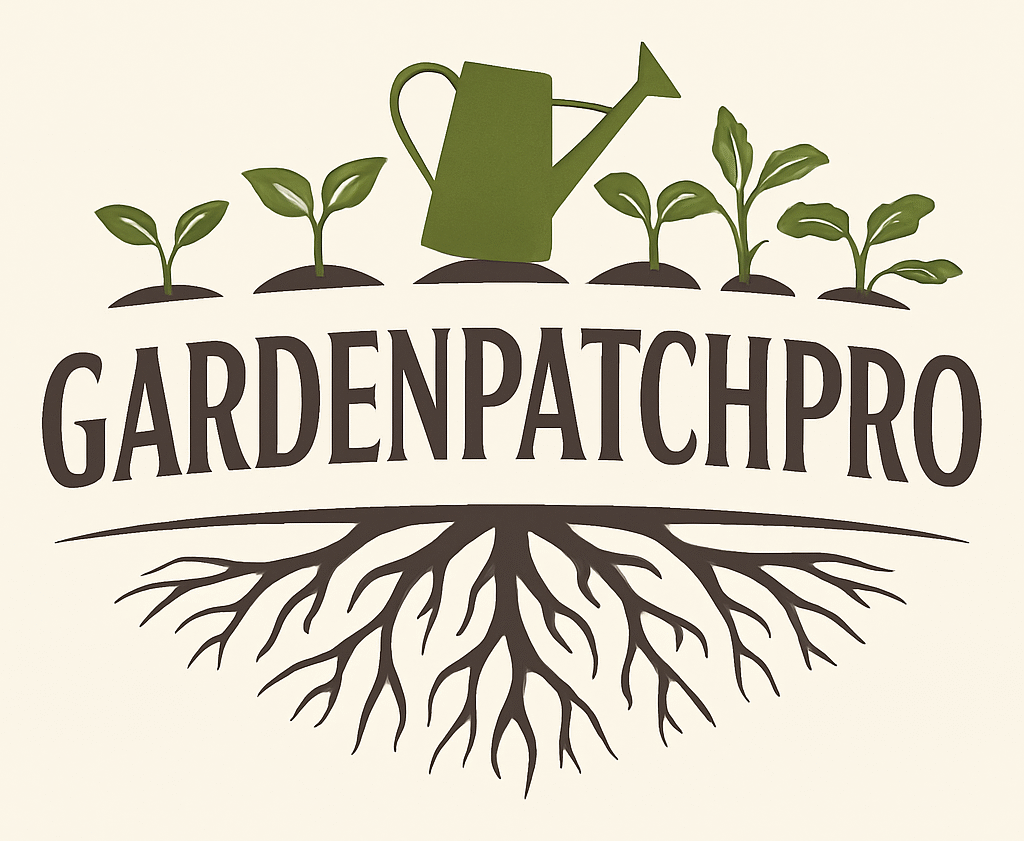Indoor Plant Care Tips: The Complete Guide for Healthy Houseplants
Indoor plants bring life and color to any space, but keeping them healthy requires the right care. The key to thriving indoor plants is understanding their basic needs like light, water, and soil. Providing the right balance of water, light, and nutrients is essential to help houseplants grow strong and stay vibrant.

Each type of indoor plant has specific requirements, so learning how to meet those needs will prevent common problems such as overwatering or poor lighting. Small habits like checking soil moisture and choosing the right potting mix make a big difference in a plant’s health.
By following simple care steps, anyone can create a green, inviting space that lasts. This article shares practical tips and clear guidance to help both beginners and experienced plant owners maintain happy, thriving indoor plants.
Key Takeaways
- Proper watering and lighting keep plants healthy.
- Using the right soil and feeding supports growth.
- Regular care prevents common plant problems.
Essential Indoor Plant Care Practices
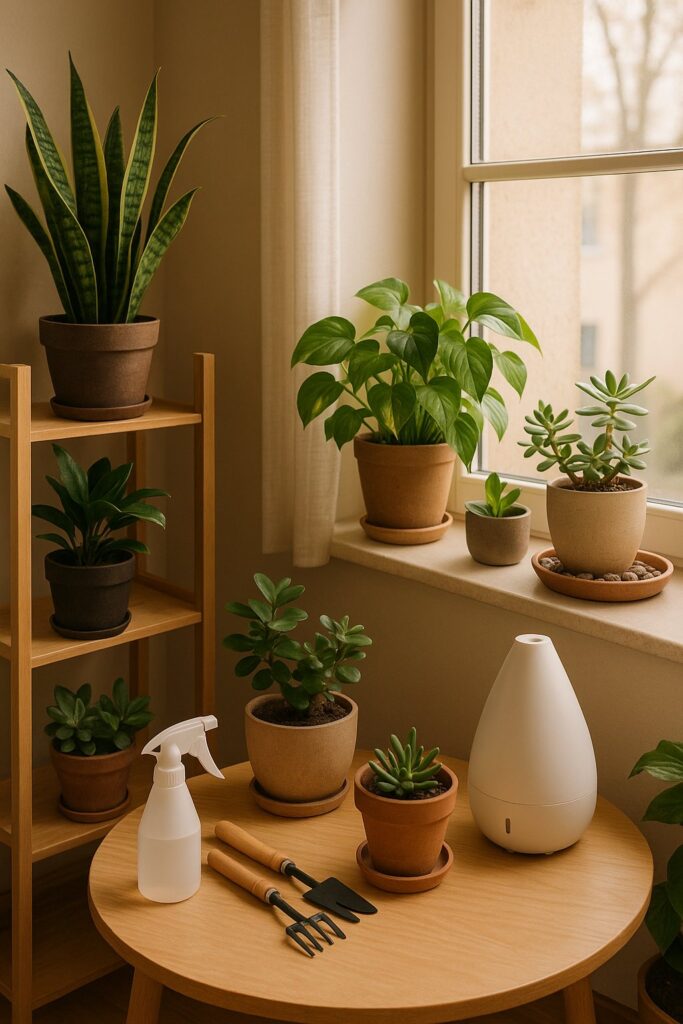
Successful indoor plant care depends on providing the right environment for each plant’s needs. This involves finding a suitable spot in the home, managing light levels, and keeping humidity and temperature within ideal ranges. Attention to these factors supports healthy plant growth and prevents common issues like wilting or slow development.
Choosing the Right Location
The location chosen for houseplants affects their health greatly. Plants need enough space to grow and should be placed where they won’t be disturbed often. Avoid placing plants in drafty areas or near heating vents, as sudden temperature changes can stress them.
Common spots include windowsills or corners with good light. North-facing windows usually receive less sun, making them ideal for plants that thrive in low or indirect light. West-facing windows get stronger afternoon sun, suitable for plants that tolerate direct sunlight. Rotating plants every few weeks helps even out exposure and encourages balanced growth.
Creating Proper Light Conditions
Lighting is one of the most important factors in indoor plant care. Some plants require bright, indirect light, while others need direct sunlight to thrive. For example, snake plants and pothos do well in low to medium indirect light, but succulents often need at least a few hours of direct sun daily.
If natural light is limited, grow lights can supplement or replace sunlight. These lights provide the right spectrum for photosynthesis and can be placed above plants for 12-16 hours a day. Monitoring the plant’s reaction to light helps prevent burns or stretching caused by insufficient light.
Ensuring Correct Humidity and Temperature
Indoor plants need stable humidity and temperature to grow well. Most houseplants do best with humidity levels between 40% and 60%. Dry air from heaters or air conditioners can cause leaf browning or poor growth. To raise humidity, owners can mist plants, use a tray of water with pebbles, or employ a humidifier.
Temperature is also crucial. Room-temperature water should be used when watering to avoid shock. Ideal indoor temperatures for most plants range from 65°F to 75°F during the day and slightly cooler at night. Sudden temperature shifts or cold drafts can harm plants and slow growth.
Watering Techniques and Best Practices

Proper watering keeps plants healthy and prevents common problems like root rot or leaf yellowing. The right timing, water quality, and method all matter. Different plants such as succulents, African violets, and orchids have unique needs that affect how and when they should be watered.
How to Determine When to Water
The best way to know if a plant needs water is to check the soil moisture. He or she can stick a finger about two inches into the soil. If it feels dry, it’s time to water. For larger pots, a moisture meter can provide a more accurate reading.
Different types of plants need water at different rates. Succulents and cacti dry out slower and need less frequent watering. Tropical plants like African violets and orchids usually need more regular watering but never want soggy soil. Too much water can cause root rot, which shows as yellowing, mushy leaves.
Watering until excess drains from the pot helps make sure the entire root ball gets moisture. It’s important to water evenly around the soil, not just in one spot.
Water Quality and Temperature Considerations
Filtered or distilled water is often best, especially in homes with hard or heavily chlorinated tap water. Minerals and salts in untreated water can build up in the soil, harming roots and causing leaf spots.
Room-temperature water works best. Cold water can shock roots, slowing plant growth. Warm water absorbs faster into the soil, helping roots take up moisture efficiently.
Plants like orchids and African violets are more sensitive to water quality, so using water without chemicals is important. Succulents and cacti are more tolerant but still benefit from clean water.
Common Watering Mistakes to Avoid
Overwatering is the most frequent mistake and can quickly lead to root rot. Signs include wilted plants with yellow or brown leaves and soggy soil. Underwatering can cause leaf curling and dry, shrinking soil but is easier to fix than overwatering.
Watering on a strict schedule without checking soil is risky. Environmental factors like pot size, light, and humidity affect water needs. For example, plants in small pots or bright light need water more often.
Bottom watering is less recommended because it can cause salt buildup in the soil and might not reach all roots. Top watering allows better control and lets excess water drain away, avoiding waterlogged roots.
Optimizing Soil and Potting Mix
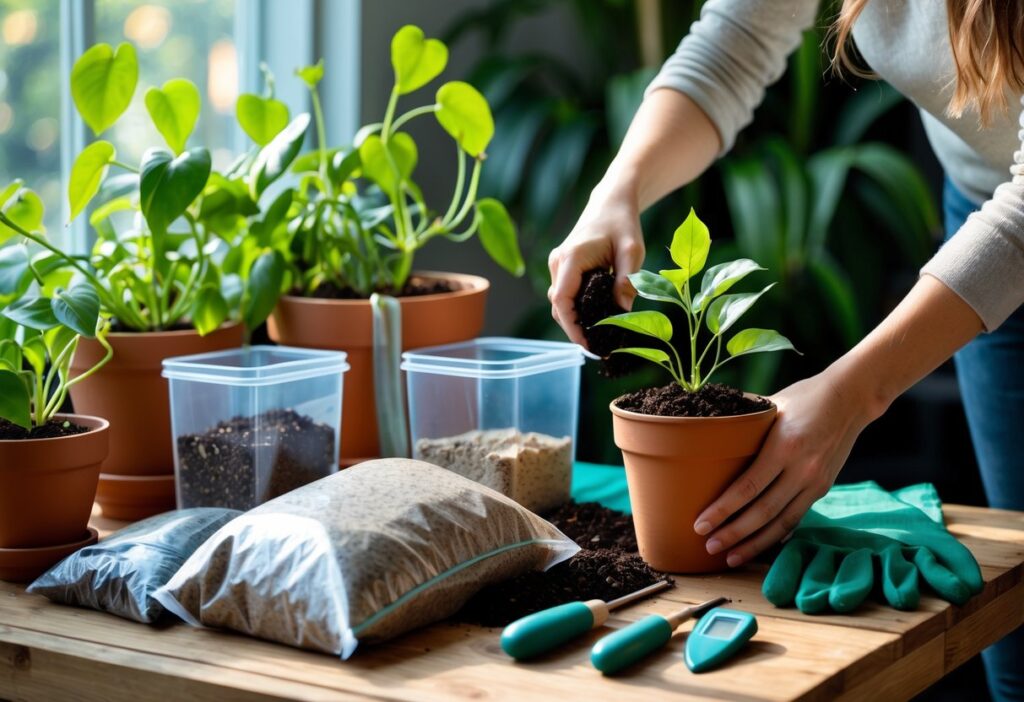
The right soil and potting mix create the foundation for healthy indoor plants. Choosing the correct blend and making sure water drains properly keeps roots strong and prevents common issues like root rot or nutrient loss. It also helps maintain balance between moisture and air in the soil.
Selecting the Best Potting Mix
A quality potting mix typically combines organic and inorganic materials to meet most indoor plants’ needs. Common components include peat moss or coco coir for moisture retention, mixed with perlite or sand to improve aeration and drainage.
Plants like succulents require soil with more sand and perlite to prevent excess moisture. Meanwhile, tropical plants benefit from a richer mix with more peat moss or coco coir.
Using pre-made potting soil designed for indoor plants can save time but adding amendments like perlite helps improve structure. When repotting, fresh soil encourages healthy root growth and prevents diseases from old, compacted soil.
Improving Drainage for Healthy Roots
Good drainage is essential to prevent water from pooling near roots. A pot must have drainage holes to allow excess water to escape. Potting mixes with too much organic matter can hold too much water, suffocating roots and causing root rot.
Adding perlite or coarse sand improves drainage by creating tiny air pockets in the soil. This air space is critical for roots to get oxygen. A layered approach during repotting, such as placing small gravel at the pot’s bottom, can also help water flow out more easily.
Regularly checking soil moisture and using a well-draining mix protect plants from overwatering problems.
Understanding Amendments and Additives
Amendments modify soil properties to fit specific plant needs. For indoor soil, peat moss and coco coir increase water retention and provide organic nutrients. Perlite and sand improve drainage and prevent compaction.
Adding compost or organic fertilizer supplies nutrients slowly over time. However, over-fertilizing should be avoided as it can harm roots and upset soil structure.
Some gardeners use activated charcoal or vermiculite to keep soil fresh and retain moisture without making the soil soggy. Choosing the right additives depends on the plant type and the desired balance of moisture, aeration, and nutrition.
Adjusting the potting mix when repotting ensures nutrients remain available and roots grow in healthy, well-aerated soil.
For more details on creating balanced mixes, see guides on perfect soil mixes for indoor plants.
Feeding and Fertilizing for Growth

Proper feeding improves indoor plant growth by supplying essential nutrients in the right amounts. Choosing the best fertilizer type, knowing the right feeding schedule, and recognizing nutrient problems all help plants stay healthy and strong.
Types of Fertilizer for Houseplants
Houseplants can be fed with several types of fertilizers. Liquid fertilizers are dissolved in water and absorbed quickly. They allow precise feeding and are often used every 2 to 4 weeks during active growth.
Slow-release fertilizers come as pellets or granules that release nutrients over months. They need less frequent application but offer steady feeding.
Balanced fertilizers have equal amounts of nitrogen (N), phosphorus (P), and potassium (K), which support leaf, root, and overall growth.
Synthetic fertilizers are chemically made and highly concentrated. They act fast but must be used cautiously to avoid overfeeding.
Certain plants have special needs. For example, African violets do well with balanced liquid fertilizer weekly at half strength, while orchids need low-nitrogen fertilizers with more phosphorus and potassium to bloom.
How and When to Fertilize
Plants usually need feeding during spring and summer when they grow actively. Feeding every 2 to 4 weeks with diluted liquid fertilizer is common.
Before fertilizing, it’s important to water the plant lightly. Fertilizer on dry soil can harm roots.
Slow-release fertilizers are added to soil every 2 to 3 months. They provide nutrients steadily without frequent care.
Avoid fertilizing in fall and winter when many plants rest or slow their growth. Following the fertilizer label instructions is critical to avoid too much feeding.
Recognizing Signs of Nutrient Deficiency
Plants show clear signs when lacking nutrients. Yellowing leaves often indicate nitrogen or iron deficiency.
If growth is slow or stunted, the plant may lack phosphorus or potassium. Leaf edges that turn brown or crispy can signal potassium deficiency or overfeeding problems.
Dropping leaves can mean calcium is missing.
Watching for these signs helps adjust feeding properly to keep plants healthy. Overfeeding also shows as wilting or white crust on the soil surface. This means fertilizer salts have built up and the plant needs flushing with water.
Regular observation prevents nutrient problems and supports steady indoor plant growth.
For more on fertilizer types and feeding schedules, see Feeding Indoor Plants for Optimal Growth.
Preventing and Managing Common Plant Problems
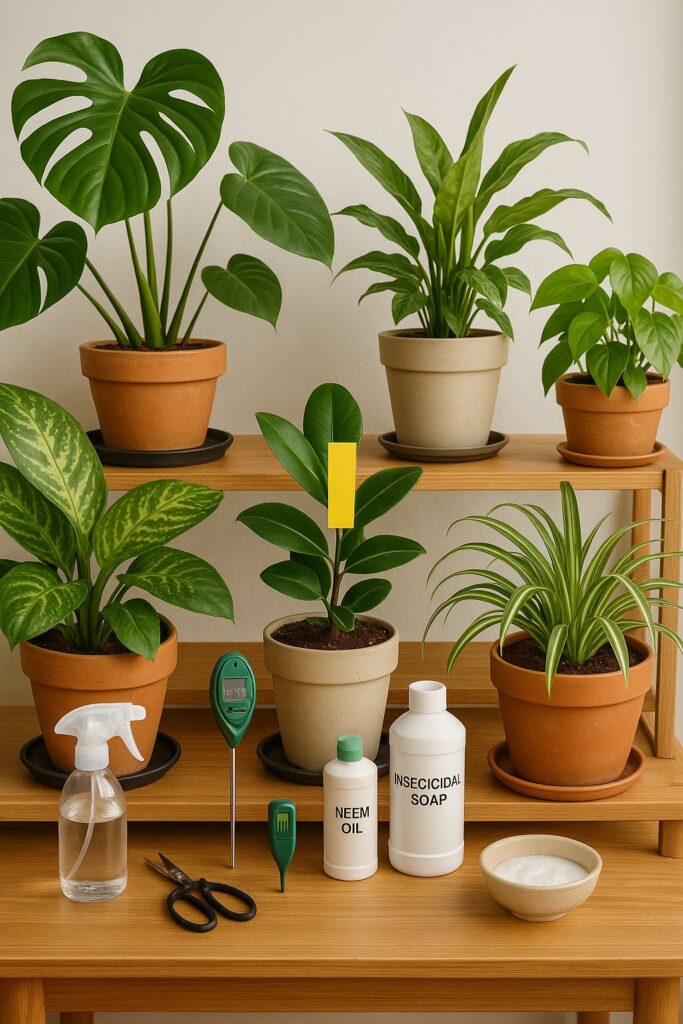
Healthy indoor plants need attention to avoid pests, diseases, and damage. Identifying issues early and applying the right treatments helps plants stay strong. Adjusting care routines based on symptoms like yellowing leaves or sticky residue can prevent further harm.
Detecting Pest Infestations
Pests like aphids, spider mites, mealybugs, and fungus gnats often show early signs such as tiny webs, sticky residue, or white cottony patches on leaves and stems. Inspect the underside of leaves and stem joints regularly.
Sticky leaves usually mean sap-feeding insects are present. Using sticky traps can monitor or reduce flying pests like fungus gnats. Washing plants with water or applying insecticidal soap helps remove small infestations. Neem oil is effective for persistent pests but should be applied carefully following instructions.
Isolation of affected plants is important to stop pests from spreading. Consistent humidity and clean foliage can reduce spider mite problems, which thrive in dry conditions.
Treating Fungal and Bacterial Issues
Fungal and bacterial infections often cause leaf spots, powdery mildew, and root rot. These problems thrive in humid, poorly ventilated areas or when watering practices create wet leaves and soggy soil.
Remove heavily infected leaves and avoid overhead watering. Improving air circulation around plants helps prevent fungal spores from spreading. A mixture of baking soda and mild soap can control powdery mildew when sprayed weekly.
Root rot develops in waterlogged soil and causes wilting even if the soil is moist. Repotting in fresh, well-draining soil and trimming mushy roots stops the condition from worsening. Ensuring pots have drainage holes and watering only when the top soil is dry prevents root issues.
Troubleshooting Yellowing and Damaged Leaves
Yellowing leaves often signal overwatering or nutrient deficiency. Checking soil moisture before watering is crucial. If the soil feels damp an inch deep, watering should be delayed.
Brown leaf tips usually result from low humidity or inconsistent watering. Grouping plants or using humidity trays can improve moisture levels. Also, keep plants away from heat vents and drafts.
Damaged leaves may also come from pests or environmental shock. Removing damaged foliage and adjusting light exposure encourages recovery. Fertilizing during the growing season helps plants regain vitality if nutrient deficiency contributes to poor leaf health.
For more in-depth advice on fixing plant problems with pests and diseases, see the guide on 10 most common indoor plant problems and how to fix them.
Care Guidelines for Popular Houseplant Types
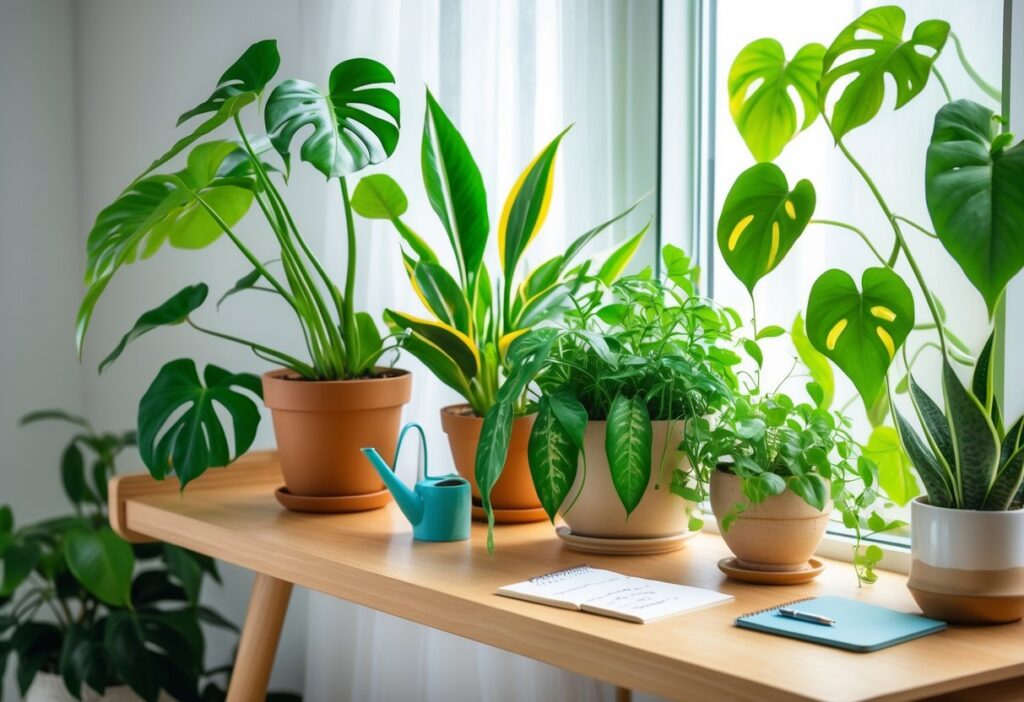
Different indoor plants need distinct care to stay healthy. Some plants thrive with little attention, while others have specific light and water needs. Paying close attention to these needs helps keep plants vibrant and growing well.
Low-Maintenance Indoor Plants
Plants like the snake plant, spider plant, and pothos are great for beginners. Snake plants need bright to low indirect light and only occasional watering, allowing soil to dry between waterings. Spider plants do well in bright, indirect light and prefer evenly moist soil but can tolerate some drying out. Pothos thrives in low to bright indirect light and needs watering when the top inch of soil feels dry.
These plants tolerate neglect better than many others, making them ideal for busy or new plant owners. They also help improve indoor air quality. They do not require frequent fertilizing but benefit from occasional feeding in spring and summer.
Specialty Care: Succulents and Cacti
Succulents and cacti need bright light and very well-draining soil. They prefer a dry environment and should be watered sparingly. Water them only when the soil is completely dry to avoid root rot.
A good rule is to water succulents and cacti deeply but infrequently. Overwatering is a common problem. These plants do not need high humidity and should be kept away from vents. Fertilize lightly during the growing season with a balanced, diluted fertilizer.
Care for Iconic Foliage Plants
Philodendrons, monsteras, and ficus plants need moderate to bright indirect light. They like moist, well-draining soil and regular watering when the top inch is dry. Avoid letting water sit in their pots to prevent root rot.
These plants benefit from occasional pruning to keep their shape and promote new growth. Wiping leaves gently removes dust and helps them absorb more light. African violets and orchids prefer higher humidity and need filtered light, with orchids benefiting from watering at the pot’s base and good air circulation.
Frequently Asked Questions
Indoor plants need the right water, light, soil, and care to grow well. Understanding how to spot watering problems, choose soil, and prevent pests helps keep plants healthy.
How often should I water my indoor plants?
Watering depends on the plant type and environment. Most plants need watering when the top inch of soil feels dry. Overwatering or underwatering can both harm plants.
What are the best practices for providing adequate light to houseplants?
Different plants need different light levels. Some require bright, direct light, while others do well in low or indirect light. Placing plants near windows or using grow lights can help meet light needs.
What are the common signs of overwatering or underwatering?
Yellowing leaves and soggy soil often show overwatering. Brown, dry leaf edges and wilting can mean underwatering. Checking soil moisture regularly helps avoid these issues.
How do I choose the right soil type for different indoor plants?
Indoor plants usually need well-draining soil. Some plants prefer specific mixes, like cactus soil for succulents or peat-based soil for tropical plants. Choosing soil that fits the plant type supports healthy roots.
What steps should I follow to repot an indoor plant?
Repot when roots grow out of drainage holes or plant growth slows. Use fresh soil and a pot slightly larger than the current one. Gently loosen the roots, place the plant in the new pot, then water it well.
What are some effective methods to prevent pest infestations in houseplants?
Regularly inspect plants for pests like aphids or spider mites. Keep leaves clean and remove dead parts. Natural sprays like neem oil and proper air circulation reduce pest risk. Isolate new plants before adding them to your collection.
